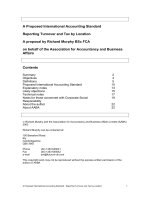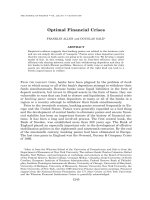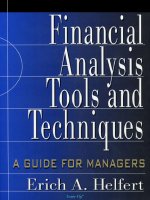Financial accounting11e by STUART a MCCRARY
Bạn đang xem bản rút gọn của tài liệu. Xem và tải ngay bản đầy đủ của tài liệu tại đây (1.43 MB, 176 trang )
Mastering
Financial Accounting
Essentials
Founded in 1807, John Wiley & Sons is the oldest independent publishing
company in the United States. With offices in North America, Europe,
Australia and Asia, Wiley is globally committed to developing and marketing print and electronic products and services for our customers’ professional and personal knowledge and understanding.
The Wiley Finance series contains books written specifically for finance
and investment professionals as well as sophisticated individual investors
and their financial advisors. Book topics range from portfolio management
to e-commerce, risk management, financial engineering, valuation and financial instrument analysis, as well as much more.
For a list of available titles, please visit our Web site at www.
WileyFinance.com.
Mastering
Financial Accounting
Essentials
The Critical Nuts and Bolts
STUART A. MCCRARY
John Wiley & Sons, Inc.
Copyright # 2010 by Stuart McCrary. All rights reserved.
Published by John Wiley & Sons, Inc., Hoboken, New Jersey.
Published simultaneously in Canada.
No part of this publication may be reproduced, stored in a retrieval system, or transmitted in
any form or by any means, electronic, mechanical, photocopying, recording, scanning, or
otherwise, except as permitted under Section 107 or 108 of the 1976 United States Copyright
Act, without either the prior written permission of the Publisher, or authorization through
payment of the appropriate per-copy fee to the Copyright Clearance Center, Inc., 222
Rosewood Drive, Danvers, MA 01923, (978) 750-8400, fax (978) 646-8600, or on the web at
www.copyright.com. Requests to the Publisher for permission should be addressed to the
Permissions Department, John Wiley & Sons, Inc., 111 River Street, Hoboken, NJ 07030,
(201) 748-6011, fax (201) 748-6008, or online at />Limit of Liability/Disclaimer of Warranty: While the publisher and author have used their best
efforts in preparing this book, they make no representations or warranties with respect to the
accuracy or completeness of the contents of this book and specifically disclaim any implied
warranties of merchantability or fitness for a particular purpose. No warranty may be created
or extended by sales representatives or written sales materials. The advice and strategies
contained herein may not be suitable for your situation. You should consult with a professional
where appropriate. Neither the publisher nor author shall be liable for any loss of profit or any
other commercial damages, including but not limited to special, incidental, consequential, or
other damages.
For general information on our other products and services or for technical support, please
contact our Customer Care Department within the United States at (800) 762-2974, outside
the United States at (317) 572-3993 or fax (317) 572-4002.
Wiley also publishes its books in a variety of electronic formats. Some content that appears in
print may not be available in electronic books. For more information about Wiley products,
visit our web site at www.wiley.com.
Library of Congress Cataloging-in-Publication Data:
McCrary, Stuart A.
Mastering financial accounting essentials : the critical nuts and bolts /
Stuart A. McCrary.
p. cm. – (Wiley finance series)
Includes index.
ISBN 978-0-470-39332-1 (cloth)
1. Accounting. 2. Financial statements. I. Title.
HF5636.M42 2010
657–dc22
2009017159
Printed in the United States of America
10 9 8 7 6 5 4 3 2 1
To my loving wife, Nancy
Contents
Preface
Acknowledgments
CHAPTER 1
Creating Ledger Accounting
Count Everything
The Beginnings of Double-Entry Accounting
Double-Entry Recording of Business Transactions
Handling Debits and Credits
Keeping Track of Data
A Mathematical Description of Double-Entry Conventions
Handling Income Items
Determining Profit in the Simple Accounting Model
Permanent Accounts Overview
Temporary Accounts Overview
Conclusion
Questions
CHAPTER 2
Accounting Conventions
Reasons Accountants Develop Conventions
Accounting Cycle
Classification
Comparability
Conservatism
Double-Entry
Full Disclosure
Focus on Addition
Generally Accepted Accounting Principles (GAAP)
Going-Concern Value
Journal Entry
Matching
xi
xiii
1
4
5
7
7
9
10
11
11
11
12
12
13
15
15
16
16
16
16
17
17
18
18
19
19
20
vii
viii
CONTENTS
Materiality
Recognition
Understandability
Usefulness
Valuation
Verifiability
Conclusion
Questions
CHAPTER 3
Balance Sheet
Balance Sheet Contains Permanent Accounts
Time Line of Cash Flows
Types of Balance Sheet Accounts
Presenting the Classified Balance Sheet
Conclusion
Question
CHAPTER 4
Adding an Income Statement
Temporary Accounts
Using Temporary Accounts
Types of Transactions Involving Temporary Accounts
Income Accounts
Single-Step Income Statement
Multistep Income Statement
Conclusion
Questions
CHAPTER 5
Timing and Accrual Accounting
Journaling Accounting Transactions
Cash Basis Accounting
Accrual Basis Accounting
Conclusion
Questions
CHAPTER 6
The Statement of Cash Flows
Importance of Cash
An Intuitive Way to Track Cash
20
20
21
21
21
22
22
23
25
25
25
27
35
36
37
39
39
40
42
44
46
46
47
49
51
51
51
52
62
63
67
67
68
Contents
Standard Accounting Categories on the Statement of
Cash Flows
Using the Indirect Method to Document Changes in the
Cash Position
Using the Direct Method to Document Changes in the
Cash Position
Producing a Statement of Cash Flows Using the
Indirect Method
Producing a Statement of Cash Flows Using the
Direct Method
Conclusion
Questions
CHAPTER 7
Ensuring Integrity
Internal Controls and Procedures
Independent Auditing
The Role of the User of Financial Statements
Conclusion
Questions
CHAPTER 8
Financial Statement Analysis
Restating Accounting Results
Ratio Analysis
Trend Analysis
Industry Analysis
Conclusion
Questions
ix
68
70
72
76
78
80
81
83
83
84
85
86
87
89
89
89
96
97
98
99
Collected Questions
101
Answers
105
About the Author
149
Index
151
Preface
M
ost accounting textbooks are written to teach accounting to future
accountants, the creators of financial statements. This book is intended
to explain financial accounting to company managers and investors, the
users of financial statements. As a result, this book will give an intuitive
understanding of the accounting process and standard accounting reports.
This text does not focus on accounting rules and therefore is not intended to
teach accounting to future accountants.
The questions at the end of each chapter follow an extended example of
a new company being created. As the company is created and grows, new
kinds of activities require accountants to record a widening variety of
business transactions. The questions follow the topic in each chapter and
don’t necessarily appear in chronological order. However, a list of accounting entries sums up the year in chronological order.
The book is written as a text for an executive master’s program in business school or part of the business curriculum in a professional degree
program (engineering, law, medicine, etc.). To respect the scarce time of the
student, the most important material will occupy the main text. Students
can read the chapters without studying the questions at the end of the
chapter, but they should work through both the chapters and questions for
a better understanding of the material.
Not every accounting student is enthusiastic about having to learn accounting. Yet they attend the class because modern business makes it important for everyone outside the accounting department to understand the
company’s accounting system.
Perhaps it would be more rewarding to start over and build a logical
accounting system from scratch. If no accounting system existed, we could
design it to meet the needs of a modern business, to be logical, and to be
understandable. But this text must describe our existing accounting system
to be useful to the reader. The reader will discover that the existing accounting system is logical and does meet the needs of modern business.
Traditional accounting textbooks are much easier to understand if the
reader already has a good grasp of accounting concepts. A reader without
prior knowledge may need to read a traditional accounting text twice
xi
xii
PREFACE
because material in the early chapters is clear only after the reader is familiar
with content in other parts of the book. This text will seek to present the
material in a way that explains the key features of modern accounting step
by step and will develop an intuitive understanding of accounting.
Although this text will not invent a new accounting system, it will introduce the concepts of modern accounting in an orderly way that sounds a bit
like the evolution of a primitive system into our current practices. This text
will start with a limited accounting system that does not include many key
features of modern accounting. These features (such as accrual accounting,
which can make accounting numbers more useful for business decisions) are
successively added, so the reader can understand how these features work
and why they are used.
Disclaimer: Financial accounting textbooks generally do not include a
disclaimer. These textbooks are published to educate students interested in
becoming accountants or to be an authoritative source on accounting rules
and methods. As explained in the Forward, this text is not written to educate future accountants or to serve as a thorough summary of accounting
rules. Instead, the book serves to explain accounting to individuals who
interact with accountants and accounting records. This text should not be
used to determine how financial statements should be prepared.
The text begins with the assumption that the reader is not familiar with
any accounting jargon and is not familiar with double-entry accounting.
Accounting concepts are introduced along with the language accountants
use to describe the process. The name of a particular account (such as ASSETS or CASH) will be written in uppercase to make it clear when the text
describes that account. Gradually, the main accounting statements are
described using the previously introduced accounting vocabulary. In this
way, the reader learns about accounting without having to have a grounding
in the topic, then gets to rehearse the language used by accountants.
Later chapters describe how businesses and users can assess the usefulness of accounting records, reduce the opportunity for fraud, and to use
accounting information intelligently.
Each chapter presents key accounting concepts. Questions at the end of
each chapter revisit these key concepts by reviewing how accountants
handle common business transactions, with answers at the back of the
book. The descriptions are short by design and some readers may want to
read more if they need to know more about particular topics not thoroughly
covered, such as valuing intangible assets, leasing, pension fund accounting,
accounting for subsidiaries, accounting for nondollar transactions, stock
options, or partnership accounting.
April 2009
Stuart A. McCrary
Acknowledgments
I
would like to thank the many people at Chicago Partners LLC (a division
of Navigant Consulting, Inc.) for their insights on presenting this accounting curriculum simply. In particular, I thank George Minkovsky for making
a careful reading of the text.
I also want to thank my students and the administration of Northwestern
University, especially program directors Walter B. Herbst and Richard
M. Lueptow. This book reflects my efforts to create an executive master’s
curriculum that covers financial accounting in an incredibly short period.
This book reflects our mutual efforts to present essential accounting information to nonaccountants so that these students can become more effect business leaders.
xiii
CHAPTER
1
Creating Ledger Accounting
I
f we set out to create the modern system of accounting, we would start
with a goal. Our accounting system is a measuring and monitoring system,
so we set as a goal to count the things that matter to a business and report
the results in a way that is helpful to the managers. This chapter takes an
important first step in providing a systematic way to count and organize
business data.
We could start with a primitive counting system using rocks and a clay
urn. This is not a history of accounting, but this text will make reference to
how primitive record keeping can be used to account for business transactions. The history of accounting is complex, and this text will not try to tell
that story. However, these early accounting tools can provide the student
with an understanding of why accounting methods evolved.
1
2
MASTERING FINANCIAL ACCOUNTING ESSENTIALS
We could use the urn to contain a count of some product our company owns.
If our retro business were importing and selling myrrh, we would add pebbles
to the urn every time a ship came in from distant lands with a supply of myrrh.
Each time we sold some myrrh, we would remove pebbles from the urn. At every
point in time, the urn would contain our count of the stock of myrrh on hand.
Of course, our business may buy and sell many different products. We
would need another urn for every product we want to count.
We could also devote an urn to the amount of debt we owe. If our currency were gold coins, we would record one pebble in the urn for each gold
coin owed to our lenders. We may need to use smaller pebbles for the debt
account, so there is room in the urn. The size of the pebble doesn’t matter
much because we really have to count the pebbles each time we want to see
how much money we owe.
Urns could help the smallest of businesses to keep track of their business, but urns are unwieldy as the number of items we need to count grows.
In addition, we do not know the count in the urn at any previous point unless we write down the count somewhere else and preserve the information
outside of our counting system. Finally, when we count the pebbles and the
thing we are tracking, we have no way to distinguish theft from human
error in updating the pebbles in the urn.
We can fix all of these problems by making the count a little differently.
If we have the clay to make urns, we might want to build a clay tablet to
count our myrrh, our debt, and anything else worth counting. One system
would use soft clay tablets and a blunt-tipped stick. Each time we buy more
myrrh, we etch a ‘‘tally mark’’ into the clay.
Creating Ledger Accounting
3
The previous system allowed us to count decreases to our stock of
myrrh as easily as increases. Unlike the hard clay urn, this tablet does not
easily let us indicate that previous inventory has been sold. If we were using
clay urns to count our myrrh, we could pull pebbles out of the urn as we
sold myrrh to our customers. To be as useful as a clay urn, we would need
to count the number of units of myrrh we acquired and the number we sold.
The next drawing shows a representation of how the soft clay tablets can be
adapted to count both increases and decreases in the amount of myrrh on
hand.
The flat stone covering a tomb or grave is called a ledger (Random House Unabridged Dictionary of the English Language, 1966).
Perhaps this stone lends its name to the soft clay tablets used to count
the assets and liabilities of this old world business. According to the
New York State Society of CPAs (www.nysscpa.org), assets are defined
as ‘‘an economic resource that is expected to be of benefit in the future’’
and liabilities are defined as the ‘‘DEBTS or obligations owed by one
entity (debtor) to another entity (creditor) payable in money, goods, or
services.’’
This clay tablet containing tallies has a couple advantages over rocks
and urns. We can indicate our location on the ledger at certain points in
time, such as at month-end and year-end. When we fill out a tablet, we
4
MASTERING FINANCIAL ACCOUNTING ESSENTIALS
can let it dry in the sun and preserve a record of our counting procedure.
In addition, we may be able to count our stock of goods with fewer,
more compact resources (tablets are smaller than most clay urns). Also,
we can quickly see a running total of these products in our accounting
records.
The next improvement over the clay tablet method is to record the tally
marks on paper. Today, paper is an inexpensive material and much lighter
than clay tablets. It is a small step from etching tally marks in a soft clay
tablet to inking tally marks on a piece of paper. Although less durable than
clay, we can introduce a second hugely important improvement. Instead of
counting the myrrh as one tally per unit of myrrh, we can use numbers to
represent quantities. This is important if we are willing to sell anything
other than standard units of myrrh. Relying on numbers and paper, we can
be much more precise in our counting.
The other feature that a paper ledger permits is to count the assets and
liabilities in currency units instead of physical quantities. For certain kinds
of assets and liabilities, this is not a change. The liabilities described as the
number of gold coins we owe a lender are denominated in currency. If we
count the number of oranges we hold and the number of apples, we can’t
directly compare the count because they are as different as apples and oranges. If we instead describe the value of the apples and the oranges instead
of the count, then we can make intelligent comparisons between the apple
count and the orange count and we can even accumulate assets into larger
subtotals with meaningful results.
Students who are new to accounting may conclude that accountants
don’t care how many apples or how many oranges we own. Of course, this
physical count can be tremendously important, but it doesn’t enter into the
primary account ledger or standard accounting reports. Modern information systems preserve a tremendous amount of this nonledger information,
which doesn’t usually appear on published financial statements. However,
this text and most other accounting texts focus primarily on the value of the
transactions and very little on physical quantities.
COUNT EVERYTHING
So far, it is not clear what assets and what liabilities we should count. The
short answer, of course, is that we should count all of them. This is a challenging task, and the bulk of this text describes how accountants keep track
of business transactions. It is important to count all assets and all liabilities
because we live in a world where there is considerable pressure to disclose
financial information to investors and creditors. More fundamentally, if we
5
Creating Ledger Accounting
TABLE 1.1 Impact of Changes in Asset and Liability Values
Type of Entry
Impact on Equity
Increase assets
Decrease assets
Increase liabilities
Decrease liabilities
Increase equity
Decrease equity
Decrease equity
Increase equity
have accurately counted all our assets and all our liabilities, we can net
the two to see ‘‘how we are doing.’’ If assets greatly exceed our liabilities,
we have equity (defined as the ‘‘residual interest in the assets of an entity
that remains after deducting its liabilities’’ (www.nysscpa.org/prof_library/
guide.htm#e)) or net worth in the business. If we don’t (or can’t) count
every asset and liability, we can’t really know how much the assets exceed
the liabilities (if at all).
So far, we have been counting only assets and liabilities. While it may
appear to be unnecessary to count our equity, it certainly would be possible
to do so. One way to count the equity is to realize that any increase in assets
(all other things being equal) increases our equity or makes us richer by an
equal amount. Likewise, a decrease in assets (again, all other things being
equal) decreases our equity by the same amount. Similarly, an increase in
liabilities makes us poorer (lowers our equity) and a decrease in a liability
increases an equity account. A list of some of the combinations appears in
Table 1.1.
THE BEGINNINGS OF
DOUBLE-ENTRY ACCOUNTING
If we count all the assets and liabilities, accountants can directly measure
the benefit of a transaction. Suppose a merchant sells myrrh that costs
5 gold coins in return for 10 gold coins. The currency account increases
by 10 gold coins (an asset), so our net worth increases by the same
10 gold coins. Our inventory of myrrh decreases by 5 gold coins, so the
net worth declines by 5 gold coins. The net of the two transactions
(which actually occur simultaneously) is to increase the firm equity by
5 gold coins.
Of course, as shown in Table 1.1, the imputed matching of transactions with changes in equity is frequently not an actual accounting reality
but does offer a perspective on the link among assets, liabilities, and
6
MASTERING FINANCIAL ACCOUNTING ESSENTIALS
TABLE 1.2 Some Combinations of Business Transactions
Type of Transaction
Offsetting Transaction
Example
Increase asset
Increase asset
Increase liability
Decrease liability
Increase liability
Decrease a different asset
Decrease a different asset
Increase asset
Decrease asset
Decrease liability
Use cash to acquire an asset
Sell used tools for cash
Borrow money to buy asset
Use cash to pay off a debt
Issue bond to repay bank
loan
equity. In the preceding sales transaction, it is also useful to think of the
mismatched change in assets (decrease in the value of myrrh in inventory
by 5 gold coins versus an increase in currency of 10 gold coins). It is no
accident that the mismatched change in assets exactly matches the
change in equity.
It will soon be obvious if we commit to count everything (including an
explicit account of the equity), that every counting transaction requires
at least two entries. In addition to the types of matched transactions in
Table 1.2, several other types of transactions are possible. Chapters 3
through 5 will describe these transactions.
Table 1.2 does not contain an exhaustive list of exchanges that are possible. Also, the value of the two transactions does not always match, so
there can be a third or more entries required to describe a business transaction. When the values of the transactions do not match, the increase or decrease in the value of the firm absorbs the difference, as with the sale of
myrrh discussed earlier.
Double-entry accounting merely recognizes that any need to count
some transaction in the business creates the need to count at least one additional offsetting transaction. Further, if all the entries are matched with
entries to equity, the offsetting equity amount not only describes the net
benefit or detriment to the firm but also quantifies the net entry required to
complete the description of the transaction.
Note that modern accounting does follow the pattern of matching each
change in asset and liability with a change in equity but in a way that will be
described in Chapters 4 and 5. After we add a few more features to our
accounting system, the receipt of 10 gold coins will be instead matched
with an equal entry called SALES, and the reduction in inventory that cost
5 gold coins will be paired with a 5-gold-coin entry called COST OF
GOODS. These are called temporary accounts that will be netted and
reclassified as equity at some point in the future.
7
Creating Ledger Accounting
DOUBLE-ENTRY RECORDING OF
BUSINESS TRANSACTIONS
As stated earlier, the value of the company equity can be calculated as the
excess value, if any, of the assets of a company over the value of the liabilities, as in Equation 1.1.
It is convenient to rearrange Equation 1.1 to become Equation 1.2
using standard algebra:
Assets À Liabilities ¼ Equity
ð1:1Þ
Assets ¼ Liabilities þ Equity
ð1:2Þ
Equation 1.2 demonstrates that the assets of the firm are owned by two
groups. The liabilities represent lenders to the company, and the equity
holders owned the excess over the value of the liabilities. Equation 1.2 represents the accountant’s view of the ownership of the company, and doubleentry accounting is a system to count or account for that ownership.
Returning to the system of clay tablets, double-entry can be viewed as a
way of keeping track of the equity of the company. Instead of tallies, record
numbers that increase the value of equity on the right-hand side of the clay
tablet. Record the assets on the left. Record the liabilities on the right-hand
side, too, because clay tablets do not accommodate negative numbers or
subtraction very well.
Returning to Equation 1.2, the value of assets equals the value of the
liabilities and equity. Because this is true both before and after each new
transaction, it must also be true of individual transactions. This balance between assets, liabilities, and equity is one of the fundamental constraints of
double-entry accounting. While it poses a challenge to the student who is
new to accounting, it also provides a valuable cross-check to make sure: (1)
that everything has been counted and (2) that they are counted in a way to
preserve the match in Equations 1.1 and 1.2.
HANDLING DEBITS AND CREDITS
Using Equation 1.2 as a model, we could set up a clay tablet accordingly.
Tallies to asset accounts (entries for assets as they are acquired) would occur
on the left column. Tallies to liabilities assumed would be placed on the
right-hand column. Similarly, tallies for equity would be placed on the
right-hand column. Furthermore, the number of tallies in the asset column
must match the number of tallies for liabilities and equity combined.
8
MASTERING FINANCIAL ACCOUNTING ESSENTIALS
Following the preceding pattern, a reduction in assets gets tallied separately from increases in assets. So tallies for increases in assets get posted to
the left column and tallies for decreases in assets get posted to the right column. Because increases to liabilities get posted on the right, decreases to
liabilities get posted on the left column. Similarly, increases to equity get
posted on the right, so decreases get posted on the left.
In a double-entry system, transactions are generally recorded in one of
two columns. Accountants use the word debit to describe an entry on the
left column and credit to describe an entry on the right column. Just like
sailors who use port and starboard to describe left and right, the two
accounting words mean little more than left and right.
The way accountants handle the debits and credits does matter. The
paper ledger needs to convey whether a particular transaction increases or
decreases the asset, liability, or equity. Several alternatives are possible, but
accountants have developed the following rules:
&
&
&
&
&
&
A debit entry for an asset reports an increase to that account.
A credit entry for an asset reports a decrease to that account.
A debit entry for a liability reports a decrease to that account.
A credit entry for a liability reports an increase to that account.
A debit entry for equity reports a decrease to that account.
A credit entry for equity reports an increase to that account.
Using this list of rules, the accountant knows how to accumulate the
impact of these accounting transactions. Notice that the assumptions are
the same for liabilities and equity but opposite for assets. Assets ¼ liabilities þ
equity both before and after an individual accounting transaction is included. It follows that any increase (debit) in an asset must be paired with
an equal decrease (credit) to another asset (e.g., buying inventory with
cash), or an increase (credit) to either a liability or equity account. The size
of the debits exactly equals the size of the credits.
The accountant’s primary job is to tally the impact of these individual
accounting entries for each asset, liability, and equity. However, by defining
the meaning of debits and credits according to the list above, the accountant
has a cross-check to identify whether all entries appear to have been included in the data correctly. If the sum of the debits equals the sum of the
credits, the accounts are ‘‘in balance.’’
If the accounts are ‘‘out of balance,’’ debits do not match credits and
something is wrong. But if the accounts are in balance, the accounting
entries could still be wrong. For example, both a debit and matching credit
could be missing. Or both the debit and credit could be incorrectly included
in duplicate. Or the wrong account may have been used.
9
Creating Ledger Accounting
KEEPING TRACK OF DATA
Modern accounting systems do not use clay urns, soft tablets, or even paper
ledgers. Instead, companies store accounting inputs in databases that may
bear no resemblance to urns, tablets, or ledger paper. Accounting textbooks, however, like to display accounting information in ways that resemble the antiquated technologies.
The T-account chronicles what was placed on a sheet of ledger paper.
In paper-based accounting, each account (CASH, INVENTORY, etc.) has a
separate sheet of paper with columns for increases and decreases to the account. The columns resemble the earliest method of accounting with clay
urns and pebbles, except that the paper can reflect currency.
Following is an example of a merchant who begins with 15 gold coins,
buys 10 units of myrrh at 1 gold coin each, and sells 1 unit of myrrh at
2 gold coins in the marketplace. The T-accounts for these transactions are
presented in Figure 1.1.
When a computer is used to keep track of the transactions, the Taccount is unwieldy. Instead, just the transaction details are recorded. For
example, the same transactions are included in the list in Table 1.3.
A MATHEMATICAL DESCRIPTION OF
DOUBLE-ENTRY CONVENTIONS
Students new to accounting may find it helpful to think of accounting as a
mathematical system. An alternative set of rules for recording transactions
appears in Table 1.4.
Under this system, you may post an increase to an asset such as EQUIPMENT together with a decrease in an asset such as CASH (i.e., the company
bought the equipment with cash). The entry to EQUIPMENT would be a
positive number and the entry to CASH would be a negative number reflecting the same amount of cash. Or you may post an increase to an asset such
as EQUIPMENT together with an increase in a liability like ACCOUNTS
Cash
Inventory
15
15
10
2
Equity
10
1
FIGURE 1.1 T-Accounts of Myrrh Transactions
1









